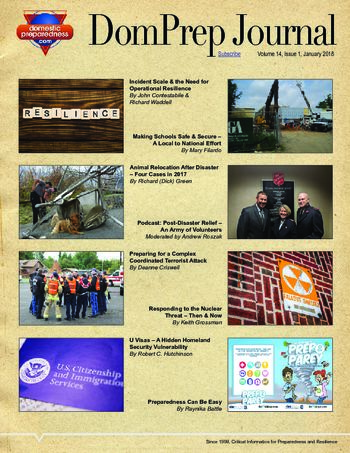

Animal Relocation After Disaster – Four Cases in 2017
Richard Green
January 31, 2018
Between late August and the end of 2017, the American Society for the Prevention of Cruelty to Animals (ASPCA) deployed to six states and the U.S. Virgin Islands in response to four disasters: Hurricanes Harvey, Irma, and Maria, and the wildfires in Northern California. In all, the ASPCA assisted nearly 37,000 animals affected by these disasters. Although each response required a unique approach, one particular objective was consistent throughout, which likely saved thousands of animal lives – animal relocation.

Preparedness Can Be Easy
Raynika Battle
January 24, 2018
For more than a decade, Federal Emergency Management Agency (FEMA) statistics have shown that, although there has been some improvement, not enough people are prepared for emergencies and disasters. However,

Incident Scale & the Need for Operational Resilience
John Contestabile and Richard Waddell
January 24, 2018
Numerous incidents occur every day in the United States, from simple/frequent events like automobile accidents, train derailments, and severe weather, to catastrophic/infrequent events like the 9/11 terrorist attacks, Hurricanes Harvey and Maria, and the Keystone pipeline leak to name just a few. By examining factors related to the incident and factors related to a specific entity, information needs and resource requirements can be better aligned to create operational resilience during any incident.

Preparing for a Complex Coordinated Terrorist Attack
Deanne Criswell
January 17, 2018
Complex coordinated terrorist attacks (CCTAs) are exactly as the name implies: large-scale attacks that are multifaceted, well-planned, and often involve multiple perpetrators. These individuals are often unknown to law enforcement, making them difficult to identify during pre-operational planning activities. Because of their size and complexity, these types of attacks far too often have a devastating impact across jurisdictions, disciplines, and even state lines.

Responding to the Nuclear Threat – Then & Now
Keith Grossman
January 17, 2018
In the civil defense era of emergency management, the federal, state, and local civil defense authorities were presented with the mission to protect the civilian population from an attack on the U.S. mainland. Shelter programs, coordinated public warning systems, emergency assistance provisions, and other protective measures were developed. Today, these measures need to be revisited and adapted in accord with current threats, timing, and resources.

U Visas – A Hidden Homeland Security Vulnerability
Robert C. Hutchinson
January 10, 2018
Immigration continues to be a relevant yet sensitive topic of discussion. Some of the most concerning immigration issues may be the ones that are more complex and not well understood by lawmakers, law enforcement, or the public. This complexity increases opportunities for abuse of an important immigration process, which then creates a significant vulnerability that is not fully appreciated until it is too late.

